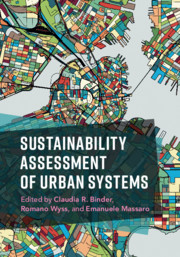Book contents
- Sustainability Assessment of Urban Systems
- Sustainability Assessment of Urban Systems
- Copyright page
- Contents
- Preface
- Acknowledgments
- Contributors
- General Introduction
- Part I Theoretical Background
- Part II Integrative Approaches for Sustainability Assessment
- Part III Perspectives on Urban Sustainability
- 10 Conceptualizing Urban Systems for Sustainability Assessment: Four Powerful Metaphors
- 11 Sustainability Issues in Urban Systems from a Metabolic Perspective
- 12 Urban-Industrial Supply Systems
- 13 Indicators for Assessing the Sustainability of Cities
- 14 Ontology-Based Integration of Urban Sustainability Indicators
- Part IV Focal Points of Urban Sustainability
- Index
- References
11 - Sustainability Issues in Urban Systems from a Metabolic Perspective
from Part III - Perspectives on Urban Sustainability
Published online by Cambridge University Press: 27 March 2020
- Sustainability Assessment of Urban Systems
- Sustainability Assessment of Urban Systems
- Copyright page
- Contents
- Preface
- Acknowledgments
- Contributors
- General Introduction
- Part I Theoretical Background
- Part II Integrative Approaches for Sustainability Assessment
- Part III Perspectives on Urban Sustainability
- 10 Conceptualizing Urban Systems for Sustainability Assessment: Four Powerful Metaphors
- 11 Sustainability Issues in Urban Systems from a Metabolic Perspective
- 12 Urban-Industrial Supply Systems
- 13 Indicators for Assessing the Sustainability of Cities
- 14 Ontology-Based Integration of Urban Sustainability Indicators
- Part IV Focal Points of Urban Sustainability
- Index
- References
Summary
This chapter provides an integrative view of the sustainability challenges of urban systems. Thereby, urban metabolism is explored as a promising framework which is often praised as offering a systemic understanding of sustainability challenges in different areas. Nevertheless, this framework still has several shortcomings. To overcome these limitations and to better understand what the urban characteristics are that make cities (un)sustainable and contribute to global (un)sustainability, we take a historical perspective. This is combined with additional pieces of evidence into a general and systemic metabolic view of the effects of urbanisation on social, environmental, and economic sustainability. The chapter concludes by proposing an integrative and transdisciplinary framework to cover the multiple facets of urban sustainability both in terms of spatial scales and from a disciplinary point of view.
- Type
- Chapter
- Information
- Sustainability Assessment of Urban Systems , pp. 261 - 289Publisher: Cambridge University PressPrint publication year: 2020



